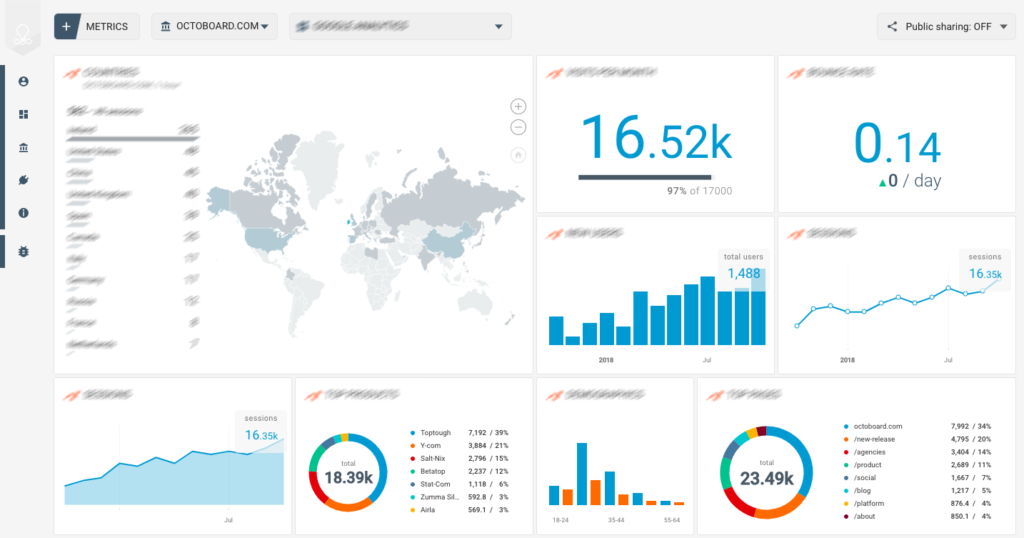Google Analytics
Google Analytics is an online analytics service that provides webmasters with a wide variety of information about the activity that takes place on their website. Google Analytics enables ecommerce businesses to segment their visitors, study traffic trends, and optimize conversion funnels — among many other functions.

google analytics
Why we need Google Analytics?
Data is viewed by metrics, which measure behavior, and dimensions, which describe who customers are. Metrics and dimensions help online businesses answer to fundamental questions:
1. Who is visiting our website? Knowing your prospects and customers informs marketing campaigns, product curation, and the very look and feel of your website.
2. What are they doing? Analyzing user behavior on an ecommerce website informs optimizations, identifies weak points (such as poorly-converting product pages), and ultimately ensures that decisions are made with an understanding of how users are interacting with a storefront.
Common data points that can be uncovered in GA include:
- Aggregate page views
- Total number of visitors
- The number of unique visitors
- Amount of time spent on site by all visitors
- The geographic location of visitors, on a country, state, and city level
- The specific terms they typed into search engines that brought them to the website
When using segments or persona-specific dimensions, online merchants can compare and contrast how different customer groups interact with their website.
Data over time
Google Analytics provides a graph it refers to as “over time,” which presents web traffic patterns across a specific (usually longer) period of time. Studying larger data sets provides more accurate insights and also helps to compare performance with business actions. For example, an online merchant may see that whenever they release a coupon code, traffic or conversion from social media spikes as a result.
Whenever any events occur that may impact website performance — either online or offline — it’s helpful to make an annotation in Google Analytics. When examining performance at a later time, an annotation may indicate a possible causation.
Setting goals
Online companies can rely on Google Analytics to help establish goals and monitor progress toward those benchmarks. In the context of macro conversions, the software can be used to edit an ecommerce site’s markup/code to track the shopping cart section of the site. It also allows for the site’s receipt page to be set up as an ecommerce transactions page goal.
Ecommerce sites should also establish goals for micro conversions — events that may eventually lead to the completion of a macro goal (usually a product purchase). These include signing up for a newsletter, URL Destination goals for created accounts, or ebook downloads (to name a few).
Google Analytics: Directional, not transactional
While it’s a strong indicator of performance, free Google Analytics accounts generally use sampled data. This data can be used directionally, as an indicator of overall performance. Sampled data cannot be relied upon for decisions that require transactional — or exact —data. Use Google Analytics in tandem with internal sales figures and investigate any data that does not quire match up.
Social Media Integration
For many marketers, social media is integrated in almost every aspect of their marketing campaigns, which is a great way to leverage the power of social media to increase awareness of your marketing efforts. But while brands invest so much time and effort into social media integration of their initiatives, many miss out on the one of the biggest ways to showcase the business’s social savvy—the website.
Social media and your website should work seamlessly together to promote your online brand.
Social share and follow buttons
Make your content shareable with social share buttons. Not only do they help you increase awareness of your content, but when you provide your visitors the opportunity to share your content easily, you’re also improving user experience. When choosing social share buttons, make sure you only choose the social networks that matter to you. By keeping it simple and easy, you’ll be able to increase the probability of your content being shared. Best practices recommend that social share buttons are placed at the top, bottom, or along the side of your page. Make sure to also include social follow buttons to increase your social media following. If you look to the right of your page, go ahead and follow us!
Social login
Did you know that 73% of users prefer to log in to a site with social login, as opposed to providing an email address and creating a new account. Improve your website visitors’ experience with social login, and increase your website registration conversions and retention. When you provide visitors the opportunity to sign up or log in via their social media profiles you’re shortening the registration process, which tends to lead to an increase in the conversion rate for user registrations. With the social data you collect through social login platforms, like LoginRadius, you’re able to collect more than 200 data points to help you make more personalized campaigns.
Social Video
Social videos are videos that are created and shared on social networks. The added bonus of social videos for marketers is that they provide an easy social media integration for your website. With so many social media platforms including video in the mix, it would be a missed opportunity to not include your social videos on your website too.